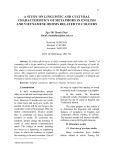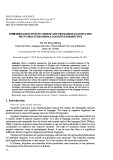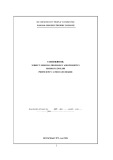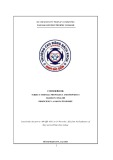
7+(617&7,&16(017,&)(785(62)
STYLISTICOXYMORONSINTHEENGLISHLANGUAGE
1HQ7KHRD
(PDLOKRDKPKRHQ
Received:05/08/2024
Revised:17/02/2025
Accepted:26/02/2025
DOI:10.59266/houjs.2025.533
EVWDFWKLVDWLHDLPVWRLGHQWLWKHVQWDWLDQGVHPDQWLHDWHVRVWLVWL
oxymorons in the English language. Some previous researchers and linguists have
studied oxymorons from dierent aspects- with a comparison and contrastin native and
non-native languages about the functions, concepts, categorizations, semantic logical
foundations,andexpressivevalues.Thearticleusesqualitativeandquantitativeresearch
methods with techniques like description, linguistic and contextual analysis, induction,
deduction, comparison,etc.Semantic elds andoxymoron types weregroupedas partof
thedatastatisticsfromacollectionof570oxymorons,basedonthesourcesofnumerous
articles,websites,plays,poems,textbooks,novels,shortstories,colloquialisms,everyday
conversations,sayingsandquotesforoneyear.Thedatawasthencombinedandanalyzedto
determinethesemanticaspectsofliteralandgurativemeaningsforthestylisticvariationof
literary,artistic,philosophical,media,andeverydayexpressions.Thisarticlewillcontribute
toavastunderstandingoftheoxymoronsoftheEnglishlanguagefromthelinguisticand
social-culturaldimensionsforbothlecturersandstudentsattheFacultyofEnglish,Hanoi
OpenUniversity.
.HRVsyntacticfeature,semanticfeatures,stylistic,oxymoron,gureofspeech.
HanoiOpenUniversity
,,QWURGFWLRQ
A comprehensive understanding of
English wordusage and linguistic devices
is essential for eective communication.
Oxymorons play a vital role in meaning
formation as both gurative speech
techniques and reasoning tools. By
DSRVLQJ RSSRVLQJ LDV SDUDRLFDOO
yet logically, oxymorons enhance literary
expression and everyday communication,
encouraging deeper reection and
interpretation.Theirabilitytocreatemulti-
ODU VPDQLF PDQLQJV DV ULFKQVV
to discourse. This study investigates the
VQDFLF DQ VPDQLF DUVR VOLVLF
oxymorons.Previousresearchhasexamined
oxymorons from various perspectives,
including their conceptual, categorical,
and expressive values, though some have
focusedsolelyontheirfunctions.Thisstudy
DLPV R FODUL RPRURQV VQDFLF DQ
VPDQLFSURSULVKURJKDDFROOFLRQ
andanalysis.Specically,itseekstoanswer:
(1) What are oxymorons’ syntactic and
semanticfeatures?(2)Whatarethecommon
stylistic types of oxymorons? A dataset

R RPRURQV DV VVPDLFDOO
collected, categorized,andanalyzed based
on their stylistic properties. The ndings
FRQULE R D EURDU QUVDQLQJ R
RPRURQVURPERKOLQJLVLFDQVRFLR
culturalperspectives.
,,/LWHUDWUHUHYLH
2.1.Denitionsonoxymoron
Anoxymoronappearswhenwords,
especially two words, are combined,
conveying contradictory meanings.
In essence, the two words are usually
antonyms, but they are not against each
other negatively. It is often realized that
K FRPELQDLRQ RVQ PDN VQV
externally. Internally, the two words
generate a gure of speech, bringing a
whole new connotation. It is explained
in Greek that “oxys” denotes “keen” or
“sharp,”and“moros”indicates“dull”or
“foolish.”The whole word “oxymoros”
implies “pointedly foolish”. The
Oxford Learner’s Dictionary denes an
“oxymoronisaphrasethatcombinestwo
RUV KD VP R E K RSSRVL R
each other.” According to the Merriam-
Webster Dictionary, the denition is
“an oxymoron is a combination of
contradictoryorincongruouswords.”The
CollinsDictionarygivesalittledierent
denition “An oxymoron is a gure of
VSFKLQKLFKRSSRVLRUFRQUDLFRU
ideasortermsarecombined.”
2.2. Oxymoron as a stylistic
FRPPQLFDWLHWRRO
In a similar study, Oxymoron is
a valid subset of the phrases known as
“contradiction in terms” (Fletcher &
Olwyler, 1997). The purposeful usage
R RPRUD RU UKRULFDO LPSDF VV
KP DSDU URP RKU SDUDRV DQ
contradictions. The contradiction is
only visible because the combination of
phrasesoersanewwaytocommunicate
anotion.
7KH VQWDFWLF IHDWHV RI
Englishstylisticoxymorons
Grothe (2009) asserts that
oxymoronscanoccuratthephraselevel
DQ KD RUVVRJKULQ DSKUDV
PDEORQJRKVDPVQDFLFFODVVRUD
dierentone.Inparticular,anoxymoron’s
VQDFLF UDPLQJ PD E D VQQF
level. The range ofthe oxymoron inthe
studydoesnotcoverthestylisticaspects.
According to Lederer (2008), oxymoron
comes in various frames and can occur
at the word level. Two forms can be
achieved in this situation: a. A single-
RU RPRURQ PD S R SQQ
morphemes,suchassuperette(big-small),
ludicrous (before-after), and pianoforte
(soft-loud). b. A single-word oxymoron
is made up of separate morphemes.
Spendthrift, bittersweet, speechwriting,
DQKROVRPDURPDQLQJEDULQJ
FRPSRQQV KD PLJK E FRPELQ R
formasingleterm.Hedoesnotputthem
atsentencelevel.
7KH VHPDQWLF IHDWHV RI
Englishstylisticoxymorons
Fortheroleofoxymorons,Pavlovich
(1979) believes that an oxymoron is a
gureofspeechmadeupoftwoelements
that stand in opposition to one another.
Heonlystudiestheuseofoxymoronsin
thecognitiveaspectsofacertainkindof
frames. Shestakova (1994) reveals that
K ORJLFDOVPDQLF OD R LVQFLRQ
governs the understanding of attributive
oxymoron combinations, where one of
KFRQUDLFRUDUVLVVEFRK
combinedsemanticsofthecombinations,
restoring its logical balance.A semantic
UODLRQVKLS KD SURFV DQ PSKDLF
RU SLJUDPPDLF LPSDF EQ K
PDQLQJV R R OLFDO QLV LV FDOO
opposition.

2.5.Thepreviousresearch
Flayih (2009) examines how
RSSRVLO PDQLQJO RUV RU SKUDVV
are intentionally combined for eect,
focusing on their ironic, humorous,
paradoxical, or emphatic functions.
However, his studyis limited tospecic
contextual uses. Ayupova et al. (2024)
FRPSDU K VUFU DQ VPDQLFV
of oxymorons in English and Russian,
UOLQJ RQ UTQF DQ VPDQLF
DQDOVLV R SORU LPSOLFL DQ SOLFL
oxymorons. Their research highlights
stylistic and cultural perspectives but
lacks a deep linguistic analysis.Nguyễn
Thế Truyền (2005) studies oxymorons
in terms of concepts, categorization,
semanticlogic,andexpressivevalue.He
SORUVFRQUDLFLRQVLQERKVPDQLFV
and user perspectives through dierent
OLQJLVLF KRULV E RV QR DUVV
their stylistic function. Unlike previous
studies,thisarticlesystematicallyanalyzes
KVQDFLFDQVPDQLFFKDUDFULVLFV
R VOLVLF RPRURQV LQ (QJOLVK
through data collection, categorization,
and analysis. It contributes to a broader
QUVDQLQJ R (QJOLVK RPRURQV
URP ERK OLQJLVLF DQ VRFLRFOUDO
perspectives.
,,,0HWRGRORJ
3.1.ContextoftheStudy
7KLVVDVFRQFRDUVV
the need for a comprehensive reference
on gures of speech among lecturers
and students at the Faculty of English,
Hanoi Open University. It serves as a
resourceforcoursesinLexico-semantics,
Translation, Speaking, and Writing
skills.Additionally,lecturerscanusethis
researchtodevelopexercisesthatenhance
students’vocabularyacquisition.
3.2.Scope of the Studyand Data
ROOHFWLRQ
7K V DQDO RPRURQV
collectedfromvarioussources,including
articles,websites,plays,poems,textbooks,
novels, short stories, colloquialisms,
conversations, sayings, and quotes. The
VOFLRQ SURFVV FRQVLU VOLVLF
and semantic criteria such as humor,
description, sarcasm, paradox, emotion,
andchild-orientedexpressions.Overone
year,approximately570oxymoronswere
gathered using computational methods,
with exclusions for jargon, slang, and
taboo words. The collected oxymorons
span multiple discourse types, including
literary,artistic,philosophical,media,and
everydaycommunication.
5HVHDFK 0HWKRV DQ DWD
QDOVLV
A mixed-method approach,
incorporating both qualitative and
quantitative techniques, was applied.
9DULRV OLQJLVLF SDUQV U
examined based on settings, genres, and
corporal. Analytical methods such as
description, contextual and linguistic
analysis, induction, deduction, and
comparison were employed. Oxymorons
U FDJRUL DFFRULQJ R VPDQLF
elds, allowing for statistical analysis
of their frequency, adaptability, and
distinctivecharacteristics.Thestudyalso
examined syntactic patterns, focusing
RQ VERULQDLRQ DQ FRRULQDLRQ D
the phrase and sentence levels, and
DQDOKLQUSODEQOLUDODQ
gurative meanings in dierent stylistic
contexts.
IV.Majorndingsanddiscussions
The following results provide
LQVLJKV LQR K QLT OLQJLVLF DQ
UKRULFDO FKQLTV V LQ RPRURQ
use, indicating cultural and stylistic
preferences. The study claries how
oxymoronsserveasstylistictechniquesto
expresscontradiction,contrast,anddepth
ofmeaning,demonstratingtheadaptability
andinventivenessoflanguageusage.

QWDFWLF IHDWHV RI VWOLVWLF
oxymorons
QWDWLD VWLVWL
oxymoronscanbeclassiedintophrases.
Based on Grothe (2009) with the
VUFU R RPRURQ D K SKUDV
level and sometimes sentence level in
the pragmatic aspects, Pavlovich (1979)
with the role of oxymorons in a variety
ofsyntacticframesjustforthecognitive
aspects, and Lederer (2008) with the
varioussyntacticframesoccurringatthe
word level, this study has expanded the
SUDJPDLF UDQJ R RPRURQV LK K
stylisticusageofoxymoronsintheseven
popularandadaptablesyntacticstructures.
6RPVQDFLFVUFUVDQDPSOV
DUPQLRQLQVQQFVDVROORV
a) Verb + adverb: He could stay
awayfromschool.Sheactsnaturally.
b) Adverb + adjective/ adverb;
Faith unfaithful kept him falsely true.
It is awfully good. She has a painfully
beautifulfeeling.Thedogisprettyerce.
The cake is disgustinglydelicious.They
are all alone together. His behavior is
seriouslyfunny.
c) verb + prepositional phrase; He
killsthecatwithkindness.
d)Adjective+Adjective;Theliving
deadissaidtorise.Thecatlooksdrowsy
andvivacious.Myleastfavoritecharacters
arereconsidered.Itisthelargerhalf.Itis
bittersweet.
e) Adjective + Noun: It is an
open secret.They need virtual reality to
practice.Thisistheoriginalcopyofher
handouts.Thatisanunpopularcelebrity.
Hedoesn’tneedtheexactestimate.This
is the impossible solution. I know her
noticeableabsence.
f)Adverb+Verb;Isilentlyscream
for help. He denitely may be here. He
clearlymisunderstood.
g)Nounnoun:Thiscallsforabsolute
honesty and cunning. It is a love-hate
relationship.Sheneedszerotolerance.It
istherelationshipoftheguesthost.Itisa
matteroflove-hate.
Via the above classication, it is
VQ KD KVQDFLF DUV EORQJR
R VUFUDO FRQFSV VERULQDLRQ
andcoordination.Inmostcases,therst
component often acts as a modier and
K VFRQ FRPSRQQ RQ DFV DV K
head. In some cases, the rst and the
secondcomponentsareofequalvalues.It
iscalledcoordination.Infact,therearenot
manycasesofcoordinationbeingused.
QWDWLD VWLVWL
oxymoronscanbeclassiedintosentences.
a)Thepredicateiscontrastedtothe
complement: He is found missing. The
cakeisgrowingsmaller.
b)Thesubjectisversusthepredicate:
Silence sings allaround me. My headis
bound with a band. His eyes were wide
shut.Thelessisthemore.
c) The predicate is opposed to the
object:Iwillgotothewaterandseehim
out of sight). We agreed to disagree on
certainthings.Pressthebraketostart.
d) The subject opposes the object:
7KJUDVKDVSULQJVURPKJUDV
love.
e) The subject is opposed to the
complement:Thissilenceisdeafening.A
friendtoeverybodyisafriendtonobody.
An oxymoron is a distinctive
stylistic device that merges opposing
ideas to form a new, complex meaning
rather than simply combining antonyms.
Unlike antithesis, which highlights
contrast, oxymoron preserves a logical
FRQQFLRQEQLVFRPSRQQVKLO
creatinganovelconcept.Italsoservesas
apsychologicalandculturalphenomenon,
momentarily disrupting conventional

thought patterns and evoking a striking
cognitiveeect.Byintroducingelements
of paradox, irony, and contradiction,
RPRURQV UVKDS SUFSLRQ DQ
enhanceexpressiveimpact.
HPDQWLF IHDWHV RI VWOLVWLF
oxymorons
Each eld reects a nuance of
meaning. It can be a stronger orweaker
irony. There are dierent types of
oxymoronswithdierentkindsandlayers
of meanings. The following oxymorons
DUJURSDFFRULQJRKPRVSRSODU
SVLKVLPLODUVPDQLFFKDUDFULVLF
featuresbasedonthecriteriaoffrequency,
style, adaptability, and semantic elds.
Throughthosegroupsofoxymorons,their
distinctive features of semantic aspects
canberevealed.
4.2.1.Comicaloxymorons
Most of the following comical
oxymorons convey humorous aspects.
Sometimes, they are called “opinion
oxymoron”. They reect an assumption
of joyfulness, evoking laughter or
amusement.Thecomicaloxymoronscan
be a means of education. They reect
the implicit assumption, providing some
moralteachingsorvalues.Amongthe95
comical oxymorons, the most noticeable
examples are: terribly pleased, literally
gurative,peaceforce,largerhalf,passive
aggression, liquid-solid, quiet scream,
harmonic dissonance, seriously casual,
incredibly real, uninvited guest, real
fantasy,virtualsubstance,activestandstill,
truelies,activelylazy,certainpossibility,
same opposite, purposeful accident, real
mirage,openlysecretive,etc…
Table4.2.1:Dierenteldsofcomicaloxymoronsforsemanticuse
7SHVRI
RPRURQV
/LWHUDU
HSUHVVLRQV
3LORVRSLFDO
HSUHVVLRQV
UWLVWLF
HSUHVVLRQV
0HGLD
HSUHVVLRQV
(YHUGD
HSUHVVLRQV
LUDO
Figurative
ItcanbeseenfromTable4.2.1thatthe
QPEURVUVRUERKSVRPDQLQJV
is nearly the same, but the adaptability
of the gurative meanings is bigger. In
dierentstyles,theliteraryandtheartistic
SUVVLRQVDFFRQRUKKLJKVQPEU
of uses. The philosophical expressions
witnessthelowestnumber,with only six
VV LQ K OLUDO PDQLQJ DQ KU LQ
the gurative meaning. The media and
everydayexpressionsexperiencethesame
number of uses in literal and gurative
meanings. Notably, the literalmeaning in
useisthesameforthepressandeveryday
expressionswith11uses.
4.2.2.Descriptiveoxymorons
Descriptive oxymorons are mostly
used to create new, evocative meanings.
Unlike other oxymorons, they provide rich
details and specicallyvivid images of the
matters they are describing.They helpadd
layersofcomplexityandnuancestothetexts.
In dierent semantic elds, the descriptive
oxymorons enrich the mind and ear. They
helpreadersgetmoreaccesstothegurative
meanings.Descriptiveoxymoronsalsohelp
createalayerofdeepemotionalexpressions,
EULQJLQJ DER DPRU LPSDFOSLFU R
ideas.Amongthe105descriptiveoxymorons,
KPRVQRLFDEODPSOVDUPDQDRU
option,openlyhidden,plasticglasses,silent
scream, soft rock, constant variable, crash
landing, detailed summary, dry ice, exact
estimate, deep shallows, dull shine, empty
fullness,fastturtle,feeblestrength,fullvoid,
genuineimitation,hardpillow,heavyfeather,
high lows, innocent guilt, joyful sorrow,
known unknowns, light darkness, minor
crisis,etc,…





![[Chuẩn nhất] Ngữ Pháp Cơ Bản: Sự Phối Hợp Thì (Sequence of Tenses) trong Tiếng Anh](https://cdn.tailieu.vn/images/document/thumbnail/2025/20250311/tinhtamdacy000/135x160/1246685478.jpg)






![Tài liệu Từ vựng tiếng Anh Trung cấp [mới nhất]](https://cdn.tailieu.vn/images/document/thumbnail/2025/20250913/nguyentuan250421@gmail.com/135x160/99491757910839.jpg)
![Tài liệu Từ vựng Tiếng Anh theo chủ đề [mới nhất]](https://cdn.tailieu.vn/images/document/thumbnail/2025/20250913/namdhuet@gmail.com/135x160/83251757753810.jpg)



![Tài liệu Từ vựng tiếng Anh cho bé [chuẩn nhất/mới nhất]](https://cdn.tailieu.vn/images/document/thumbnail/2025/20250731/huadaithesang2509@gmail.com/135x160/18631754013896.jpg)








